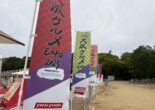Local Japan: Kagoshima – Living with an Active Volcano
Waking up in Japan never became completely routine to me. Even in a western-style apartment in Tokyo, I saw an unfamiliar skyline to my right every morning. In Kagoshima, the difference was even more startling for someone who had grown up in a place like Texas, where calling the landscape flat is an understatement. It wasn’t unusual to see a little cloud over Sakurajima, the volcano overlooking Kinko Bay, caused by either typical weather or a small amount of ash spewing out.
One of the first things expats in Japan learn to dread is how to sort their garbage to be accepted by the city. Plastic on Tuesdays, different plastic on Wednesday, different plastic every second Thursday, but not if it’s a holiday… Kagoshima has this as well, but also distributes yellow refuse bags for its residents to collect any excess ash that has fallen. In addition to dealing with rain, typhoons, and earthquakes, people in Kagoshima learn not to leave their clothes out at certain times of the year, lest they be splattered with gray when they return home.
 It could easily be one of those mornings when I wake up in my small Yoshino Town apartment. Though a bit far from the train connecting the city with the rest of Kyushu, Yoshino has its share of perks: history as the hometown of Saigo Takamori; a neighborhood hot springs for only 360 yen. The town also happened to be closer to the office where I worked, cutting down my commute – and increasing my sleeping time – by a good twenty minutes.
It could easily be one of those mornings when I wake up in my small Yoshino Town apartment. Though a bit far from the train connecting the city with the rest of Kyushu, Yoshino has its share of perks: history as the hometown of Saigo Takamori; a neighborhood hot springs for only 360 yen. The town also happened to be closer to the office where I worked, cutting down my commute – and increasing my sleeping time – by a good twenty minutes.
Unlike my first year in Japan, spent navigating the culture and learning not to yell at my eikaiwa manager for making unreasonable demands, my second year was when I took charge and found a professional job as a translator and proofreader at a biomedical firm in Kagoshima. I was definitely hired as a fixer-upper, with my business Japanese still at a pitiful level, but escaping the English teaching world was just too good of an opportunity to not accept.
Kyushu was and still is a completely different world from East Japan and the urban sprawl of Kanto and Kansai. Hot springs dominate the countryside. Even in a city like Kagoshima, there’s less stress than Tokyo: fewer lines, milder winter, lower cost of living, bigger apartments.
For me, it always comes down to the best places to run. I usually awoke and inhaled some cereal before dashing out into Yoshino during the pre-dawn hours. If I’m lucky, there won’t be any ash falling, but it’s hard to avoid the smell of the chicken coops right next to the supermarket… I sure hope they get their eggs fresh. Living in this corner of Japan means little traffic and even fewer runners all the way from Yoshino Town to the lookout point in Terayama Park.
A few locals have spotted me this way and tell me so when they see me downtown, though I honestly don’t know how: I’m running past farmhouses and self-service vegetable stands, not convenience stores and apartment buildings. Understanding the people isn’t so difficult, and I’ve rather enjoyed learning the Kagoshima dialect. Only older residents still use it regularly, which means it comes in handy with taxi drivers.

As soon as I put in a good 10-15 km and return to my absurdly minimalist flat, I probably have 10-15 minutes to shower, dress, and pack lunch before the company bus comes by at 7:45. I’ve missed it on more than one occasion, forcing me to walk down the street and negotiate a rate for a taxi that won’t make me regret the extra ten minutes to myself. On the other hand, if I plan ahead, I can also commute by bike.
My company is so far away from anything in Kagoshima and Yoshino it’s no surprise they offer private buses. On a rainy day, you might think it’s the end of the world to miss my ride, but because the area is rich in hot springs, the office always allowed me to use their on-site one for free. I’ve been yelled at for leaving my belongings in the lockers when corporate bigwigs were visiting, but for the most part, I was able to get in a quick soak before work, or maybe just wet my feet at lunch.
As for the work itself, this job was the one that made me realize there’s more to life than simply a salary. Here I was, a non-native Japanese speaker, working in a full-on Japanese company, singing the company song at the weekly morning meeting, communicating with Japanese scientists regarding their language choices so I could clean up translations, and pulling in far more money than I ever had or ever could at an eikaiwa… and I was completely understimulated. Work was staring at a computer screen checking documents all day, with the occasional tea break and Japanese test enforced by my supervisor.
I was craving balance: the social interaction of being an English teacher with the professionalism of company work. It would take me years to find it.
When quitting time sounded at 5:30, most of us were still at our desks going strong. Not so much because we were busy, but because the only bus going home didn’t leave until 6:00. I have to give it to them – it’s a rather clever way to milk more work out of employees. Unlike companies in Tokyo with some salarymen staying until the wee hours, the last bus left at 7:30, meaning there was only so much unpaid overtime workers could do if they didn’t have cars.
I was always on that 6:00 bus, or out the door a few minutes after 5:30 if I had come by bike. Usually it would be the bus, so I could take it past my apartment and all the way into downtown Kagoshima, where I’d arrive at exactly 6:22 (thank you Japanese efficiency), walk for ten minutes over to Kagoshima Chuo Station, and hit the gym.
Whenever I settle in one place, I tend to be a creature of habit ad extremum to maintain my health; once I find something that suits me, I stick with it for days, months, and even years if I’m around long enough. In Kagoshima, this meant arriving at the gym three times a week at almost precisely the same minute, finishing around 8:00 and heading to the nearest restaurant to eat one of the three variations of a four-course dinner for 1500 yen. After nine months, every last member of the staff knew me well enough – plunking down several hundred dollars didn’t hurt – that they offered my visiting parents and I a round of drinks on the house, “service” in Japan.
The most convenient bus back to Yoshino Town left at 9:22. My Rapica (IC) card helps expedite my entry and exit, but even though I know exactly which stop is closest to my apartment, I may get off at the one just before – not because I have any errands to run, but simply because walking an extra five minutes saves me 30 yen on the journey.
Once I’m finally home, I tend to appreciate the little things: a cup of green tea drunk with a pastry or cookie I had picked up at Kagoshima Chuo; streaming video of The Daily Show to catch up on US events; the emptiness of the room, save a single bed, bookshelf, table, and rug. My adventures are seldom during the week, but rather reserved for those weekends when the ferry schedule to the Tokara island chain lines up perfectly, giving me the perfect excuse to escape. I’ve visited Nakanoshima to see the wild horses, Ioujima for the outdoor hot springs, Amami Oshima to study Saigo Takamori, Yakushima for hiking, and Tanegashima for beaches and the space center.
My thoughts are still in Kagoshima, even though it’s been years. The abundance of onsen alone is enough to make me want to live there again, but there wasn’t always much in the way of socializing; I had to make my own fun with local festivals and travels. Still, as unaccustomed as I am to waking up and seeing Japan out my window every morning, there are days when I half expect to find Sakurajima smoking.




